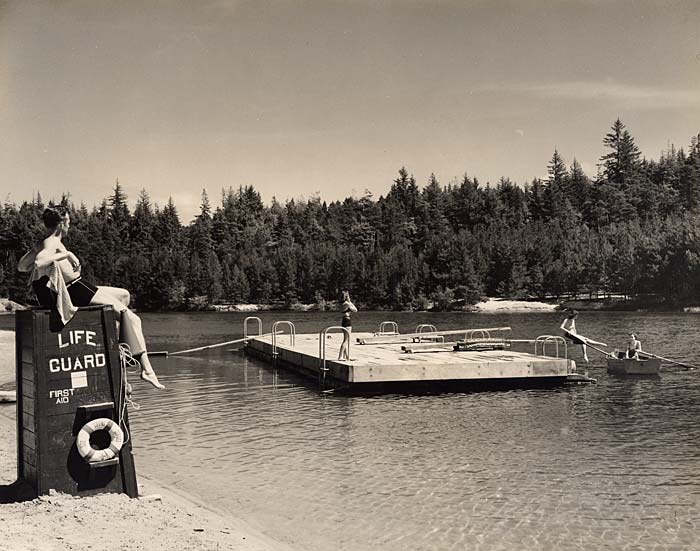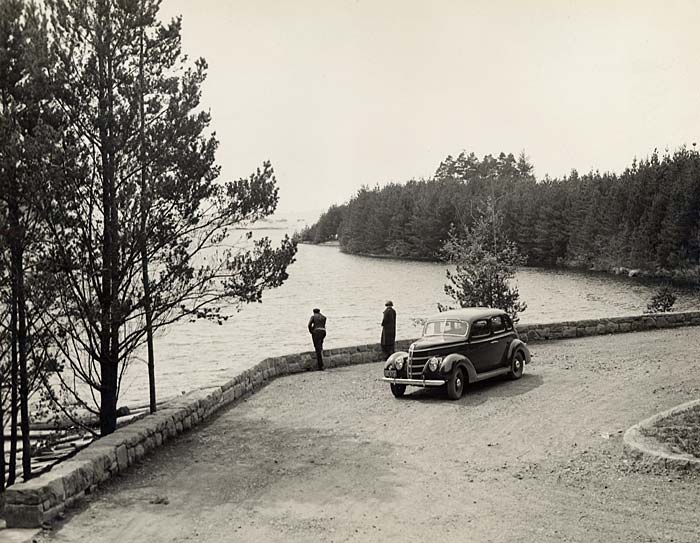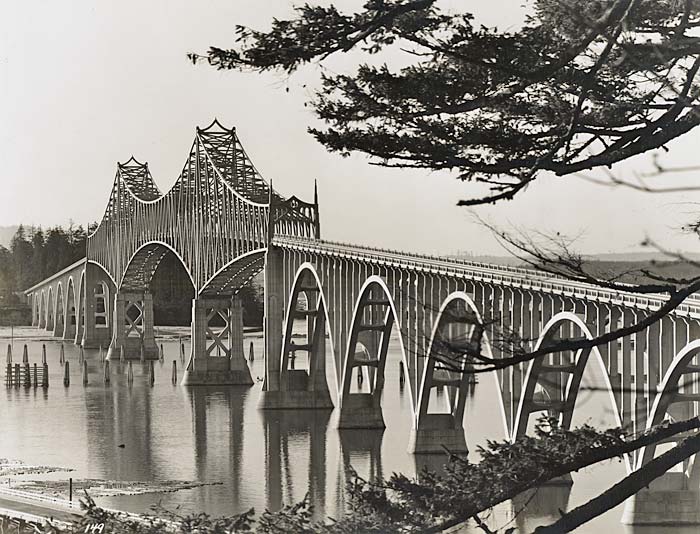FLORENCE, 50 m. (11 alt., 339 pop.), by the Siuslaw River, is a fishing town and the trading point for farmers of the small Siuslaw Valley. Florence holds an annual Rhododendron Festival. The SIUSLAW RIVER BRIDGE is another in the series carrying the highway over a difficult route.
 Siuslaw River Bridge at Florence (842). Enlarge image.
Siuslaw River Bridge at Florence (842). Enlarge image.
South of Florence, the wild azalea replaces the rhododendrons on the hills. This brightly flowered shrub thrives best in open spaces, and reaches the height of its beauty and fragrance in May and June.
The JESSIE M. HONEYMAN MEMORIAL STATE PARK, 52.7 m., was named for a woman untiring in her efforts to enhance the beauty of Oregon.
The highway now passes an area with some commercial and private summer camps.
By CLEAWOX LAKE, 53.1 m. (82 alt.), is (R.) the Eugene Area Girl Scouts' Summer Camp. WOAHINK LAKE 54.2 m., is one in a series of dune-locked lakes extending southward. (Watch for deer crossing highway; signs indicate their usual crossings.)
At 56.3 m. is the junction with a dirt road.
Left here to large SILTCOOS LAKE, 0.5 m.
The SILTCOOS RIVER, outlet of Siltcoos Lake, is crossed at 56.5 m. South of the river is a region of marching dunes where windblown sands are constantly sweeping inland. The slopes of cuts have been planted with grass and shrubs to hold them in place.
At CARTER LAKE (R.), 58.8 m., is a Forest Service campground. TAHKENITCH LAKE, 62.6 m., whose name means "many arms," is famous for bass fishing. ELBOW LAKE, 63.9 m., provides excellent fishing.
 Honeyman Park, Cleawox Lake lifeguard (1293). Enlarge image.
Honeyman Park, Cleawox Lake lifeguard (1293). Enlarge image.
Descending rapidly, the route reaches GARDINER, 69.6 m. (18 alt., 300 pop.), established in 1850 by shipwrecked men from the "Bostonian." Its snug houses, built against the hillside, almost all of them painted white, are monuments to the preferences of Wilson F. Jewett and Asa M. Simpson, both Maine natives, who were leading figures in early lumber milling at Gardiner. Reportedly, they supplied local residents with free paint,
but only
one color,
to apply to homes and businesses. Gardiner was probably the scene of Dr. Alan Hart's novel, "Doctor Mallory" (I935). Hart practiced medicine here in 1918.
The UMPQUA RIVER BRIDGE, 71.3 m., spans the stream at a point not far west of the junction with Smith River, named for Jedediah Smith. In July 1828, Smith's party of nineteen trappers camped on the Umpqua. While Smith and two others were away from the camp on a scouting mission, the rest of the party was attacked by natives, and a substantial quantity of furs and property was taken. The only known survivor of the attack made his way to Fort Vancouver, the Hudson's Bay Company post on the Columbia River. Within days he was joined there by Smith and his two companions. The company regained much of the stolen property, then purchased furs and horses from Smith.
Near BOLON ISLAND the highway crosses a many-arched steel bridge with a cantilever span over the main channel of the Umpqua River.
REEDSPORT, 71.6 m. (28 alt., 1,178 pop.), is built on marshy tide land. Its best known citizen is Robin Reed, editor of the "Port Umpqua Courier," who is a former national amateur wrestler and Olympic champion. Most of the population lives in the dozen or so two-story rooming houses and hotels, and is composed of transient laborers. There is little residential section, the majority of the dwellings being scattered over the town's edges.
Reedsport is at the junction with State 38.
 Honeyman Park, Cleawox Lake and car (G488). Enlarge image.
Honeyman Park, Cleawox Lake and car (G488). Enlarge image.
South of Reedsport, U.S. 101 climbs through denuded hills where stumps and blackened snags give evidence of the death of the local lumber industry.
WINCHESTER BAY, 76.2 m. (16 alt., 50 pop.), is primarily a summer resort and fishing village by the Umpqua River, about 3
miles from its mouth. Across the Umpqua (R.) is the SITE OF FORT UMPQUA, established in 1856 by the U.S. Army after the close of the Rogue River Indian War. In 1862, Col. Julius Steinberger, commander of the District of Oregon, noted
"The Indians about Port Orford have been for two years thoroughly subdued...." He further observed that the trail which the fort "professes to guard is not used by Indians and has not been for some time." Soon afterward, the fort was closed. Some of its buildings, including the blockhouse, were disassembled and moved to Gardiner.
At 77.3 m. is the junction with a dirt road.
Right here to UMPQUA RIVER LIGHTHOUSE, 1 m., which began its service in 1894.
CLEAR LAKE (L.), 78.9 m., is the source of Reedsport's water supply. At 83.8 m. is (R.) the EEL CREEK RECREATIONAL AREA AND FOREST CAMP.
HAUSER, 91.3 m. (27 alt., 126 pop.), named for Eric Hauser, who constructed sections of the Southern Pacific Railroad in this area, is among extensive cranberry bogs. Flocks of wild ducks and geese feed nearby. Here, the highway veers farther inland and passes through a forested tract.
The COOS BAY BRIDGE, 97.8 m., nearly a mile long and the most costly of the bridges on U.S. 1O1, is comprised of a series of concrete arches and, over the busy channel, three of the suspension type with an elevation of 150 feet. At the south end of the bridge is SIMPSON PARK, named for Asa M. Simpson, founder of North Bend, and long identified with local lumbering and shipping. Many
have thought he was writer Peter B. Kyne's inspiration for the character, Cappy Ricks.
 Woahink Lake south of Florence (204). Enlarge image.
Woahink Lake south of Florence (204). Enlarge image.
NORTH BEND, 99.2 m. (41 alt., 4,012 pop.), is on a peninsula jutting into Coos Bay. It has a sawmill, a shipyard, three fishery plants, and a crab-packing plant.
Right from North Bend on a paved road through a suburban area to EMPIRE, 3.5 m. (43 alt., 493 pop.), formerly called Empire City. Fish canneries and mills provide local employment. Its first settlers were men from Jackson County who left there in 1853 during the local gold fever. As county seat, location of the Collector of Customs, and site for lumber milling, shipbuilding, and commerce, Empire City had years of prominence. But then business declined, and the move of the county seat to Coquille in 1896 was a further blow to the town's fortunes.
In CHARLESTON, 8.7 m. (10 alt., 150 pop.), is a COAST GUARD STATION, by the mouth of Coos Bay.
MARSHFIELD, 102.1 m. (19 alt., 5,287 pop.) is almost continuous with North Bend; together, the towns form the fifth largest city in the state. Marshfield is near the top of the crooked arm of Coos Bay, which is usually crowded with schooners being loaded with lumber cut in
forests on the slopes of the Coast Range. Of particular
importance is the Port Orford cedar, whose straight grain, lightness, and tensile strength creates a demand in world markets.
The first cabin in this district was built in 1853 by James C. Tolman, a future surveyor general of Oregon. Later, in the 1850s
and early 1860s, the future Marshfield was comprised of little more than
Capt. George Hamilton's trading post and a few dwellings. Then in 1868, John Pershbaker gave stimulus to the town's growth when he established a lumber mill in what would become the southern part of the town. The Pershbaker firm also commenced shipbuilding on Coos Bay. The vessels included a tug, the "Escort No. 1," and the schooners "Staghound," "Louisa Morrison," and "Ivanhoe."
The plant of the COOS BAY LUMBER COMPANY (open to visitors), at the northern edge of town is today the mainstay of local prosperity. When established in 1908 by Minnesota lumber baron C.A. Smith, it was a marvel of modern technology. Like the opening of a Southern Pacific rail connection between Coos Bay and Eugene eight years later, it was a major milestone in the life of Marshfield.
 Conde McCullough Memorial Bridge over Coos Bay (149). Enlarge image.
Conde McCullough Memorial Bridge over Coos Bay (149). Enlarge image.
The same year the mill opened, lumber interests funded a project to deepen the harbor channel to eighteen feet. This and other improvements to the harbor and bar in the early part of the century helped Marshfield overcome its natural handicaps, as did the raising of low-lying town land with dredged materials.
With the World War came a boom in the Coos Bay region's logging, lumber manufacture, and shipbuilding. After the war, canceled government orders and the closing of a local lumber company brought temporary hardships. Prospects for the region looked brighter by the beginning of the next decade, and Marshfield settled down to a more solid kind of development.
A fire in 1922 swept away much of Marshfield's Front Street business district. Although tragic at the time, the fire contributed to renewal of the town and a shift, already underway, of businesses away from the waterfront. The new highway has been a boon, putting the town on the second most important interstate artery of the West Coast and destroying its former isolation. A new local industry
is the working of myrtlewood into souvenirs for tourists. Another local industry is the canning of pilchards. These fish are also crushed for their oil, and the residue is treated and shipped as fertilizer and poultry food.
The Marshfield waterfront is a main attraction to imaginative visitors. Schooners from far ports dock here, and the waterfront life has the lively characteristics found only in younger ports. With the sailors mingle fishermen, as considerable commercial fishing is carried on in waters nearby.
The CITY PARK, at the north edge of town, has a large lake, picnic spots, trails and extensive plantings of luxuriant shrubs and plants native to the damp coastal area.
 Coast Highway near Reedsport (2481). Enlarge image.
Coast Highway near Reedsport (2481). Enlarge image.
On Telegraph Hill, also in the north end of the city, is a CHINESE CEMETERY. In the last century, mines in the region drew labor. Washerwoman, doctor, and salmon cannery worker were other roles filled by Chinese residing in Southwest Oregon. According to Chinese custom, many bodies were exhumed from the cemetery at Marshfield and sent to China.
South of Marshfield the native bent grass is extensively cultivated because of the wide demand for landscaping purposes.
At 107.4 m. is the junction with an improved road.
Left here to the COOS COUNTY COUNTRY CLUB (open to public; small fee), 1 m., which has a 9-hole golf course and an attractive club house.
U.S. 101 here runs through the soft-coal belt that covers in all about 500 square miles. The first mines in the Coos Bay region were opened about 1854, and for years coal played a significant role in the local economy. Mining operations are now carried on only in a small way.
Slow but definite changes in the character of vegetation occur as the route moves south. White-barked alders and yellow maples yield largely to Oregon myrtle, a glossy-leafed evergreen that here grows singly on open hillsides or in groves along the meadows. When not crowded, the trees grow so symmetrically they look as though they had been trimmed. The wood takes on a brilliant polish and is used for making novelties sold along the route. The spicy leaves can substitute for bay leaves in seasoning meats.